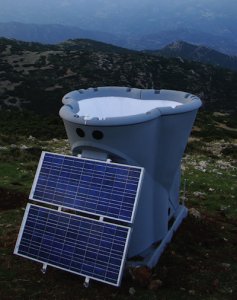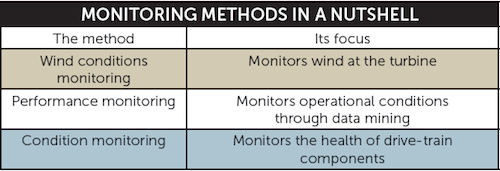There are three methods for monitoring wind-turbine operations: wind-conditions monitoring, performance monitoring, and condition monitoring. The terms are thrown around so much that many in the industry are confused. Although the terms describe different tasks, they have the same goal: performance and reliability of the wind assets.
An automotive analogy may be useful. For instance, if your car is not getting optimal fuel mileage, you get a tune-up. If that doesn’t work, you take the car to a mechanic for a more detailed analysis. So diagnosing the mileage problem is analogous to monitoring wind conditions. A tune-up is analogous to examining SCADA data, or performance monitoring. And the mechanic is akin to the analyst who finds meaning in the vibration data. Here’s more detail on each.
Monitoring wind conditions
Suppose a turbine’s power production or output is less than its power curve says it should be. Does the problem concern wind conditions or the turbine? Wind conditions monitoring may provide a clue. A wind-resource assessment of the site is performed prior to construction and at least for a year. If the resource assessment is correct, the turbine should produce predictable power. If it doesn’t make rated power, (rated for the available wind) then you will need to benchmark the conditions versus the rated power, essentially plotting the wind versus the turbine output.

The Triton from Second Wind is one of several sodar-based (wind sensor using sound) remote wind sensors. The unit can measure wind speed and direction at hub heights to give operators data to gauge a wind plant’s efficiency.
This is done with wind-conditions monitoring this way: Examine the site’s meteorological data to gauge or plot against the turbine’s output. Look for data from a met tower or remote sensor, such as a sodar unit. “Our systems measure wind conditions that can be used for wind-resource assessments,” says Naomi Pierce of Second Wind, a company that makes portable wind-sensing systems. “The equipment can be used for wind-resource assessments and monitoring operating farms. In the latter case, the equipment monitors wind and wind conditions to gauge the performance of an operating wind turbine.”
Performance monitoring based on wind conditions measures the wind potential that can be plotted against the rated power of a wind asset or site, to determine the production efficiency. Wind performance should show how much power the site can produce. If the turbine does not produce expected power, there might be a problem with the turbine. This also involves power-purchase agreements and warranty implications.
Performance monitoring
Performance monitoring is a great tool for wringing maximum performance out of a farm or fleet. This monitoring involves taking the sensor data from the wind turbine and mining (examining) it for information as to why it’s underperforming. You look for reasons why the rated power was not produced.
A tremendous amount of data comes off of a single turbine. Its sensors monitor characteristics such as:
- Yaw and pitch position
- Temperature
- Wind speed and direction
- Generator speed
There are more aspects, but mining the SCADA data can determine where performance issues lie. Steve Brost, a CMS Engineer and turbine prognostics and health management analyst, says this about performance monitoring:
“We use a software tool called T2 for identifying deviations between two or more data populations. We use it to identify deviations in trends by comparing the (multivariate) means of data populations and point out the one with the most consistent deviation. We configure a threshold in the tool to identify the ‘highest hitters’, those that deviate most. Once the tool has identified a repeat offender, a value for that data population is collected into what we call a Cusum (cumulative sum), so we can focus on locations in the turbine with the highest probability of potential failure. For example, the hottest temperature might indicate damage or confirm damage through other measurements such as vibration. The Cusum characteristic is something of an alarm threshold or a filter we can set.
After taking all Cusum values across our fleet, we examine the highest values and cross reference the findings with vibration data to focus on locations that are alarming the most frequently in vibration and temperature or other SCADA trending data such as highest fault count.”
Suppose a turbine’s temperature points to a potential problem. This element is neither sufficiently specific nor nearly as predictive as vibration-condition monitoring. But a “hot” indicator is similar to a “check engine” light in a car. It signals a problem but not specifically what is causing it.

Statistically, every tenth turbine faced relevant damage each year. Costs for a planned repair are on average less than 30% compared to the replacement of a component. (Source: DEWI). Consequential damage can be prevented.
Condition monitoring
Nothing reduces turbine efficiency more than a failed component that halts its power production. Condition monitoring using vibration in particular, aims at identifying specific component degradations. Typically, this includes sensors placed on components that are costly to repair, fail with regularity, or both. Usually and regardless of model, such components include:
- Main bearings
- Low-speed shaft, gearbox
- Planetary section, gearbox
- High-speed shaft section, gearbox
- Generator, drive end
- Generator, non-drive end
Several operational parameters (which performance monitoring can detect) ultimately increase wear on drive-train components. Performance monitoring detects these abnormalities while condition monitoring detects component wear. Hence, it is crucial to perform both. The monitoring methods work together on performance-related failures.
 For example, a rated power output may be affected by a misalignment between the gearbox and generator, or a failing high-speed shaft. Yaw deviation, the difference between wind direction and nacelle direction, can also affect power output by causing undue drive train loading. Condition monitoring detects the wear.
For example, a rated power output may be affected by a misalignment between the gearbox and generator, or a failing high-speed shaft. Yaw deviation, the difference between wind direction and nacelle direction, can also affect power output by causing undue drive train loading. Condition monitoring detects the wear.
As you would expect, not all failures or shortcomings are performance-monitoring detectable or correctable. For instance, looseness, misalignment, imbalance, and most all early detection on gear and bearing failures are impossible with factory sensors. So check the fuel efficiency on your turbine, give it a tune-up, and avoid a trip to the mechanic. Although methods for monitoring wind turbine performance have different names, all work toward the same thing: peak wind-turbine performance.
WPE
Filed Under: Uncategorized





